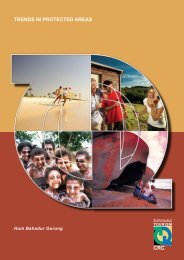icolls - Sustainable Tourism CRC
icolls - Sustainable Tourism CRC
icolls - Sustainable Tourism CRC
Create successful ePaper yourself
Turn your PDF publications into a flip-book with our unique Google optimized e-Paper software.
ECOLOGY, THREATS AND MANAGEMENT OPTIONS FOR SMALL ESTUARIES AND ICOLLS<br />
Chapter 3<br />
SEWAGE EFFLUENT SIGNIFICANTLY INCREASES THE δ 15 N<br />
SIGNATURES OF RESIDENT BIOTA IN AN INTERMITTENTLY<br />
OPEN ESTUARY<br />
Despite their appeal as sites for tourism and recreation, many ICOLLS have been deleteriously impacted by<br />
coastal development. The key impacts to date have often manifested as deteriorated water quality. This is<br />
generally the result of eutrophication or excessive delivery of nutrients from industry, agriculture and urban<br />
sources.<br />
Conditions in ICOLLS range from freshwater-dominated when closed, to estuarine and marine when open to<br />
the ocean. This variability in physical and chemical attributes ensures that ICOLLs have variable biotic<br />
community composition in time and space. When closed to the ocean, nutrient added to ICOLLs can lead to<br />
reduced water quality and increased frequency, duration and intensity of algal blooms. One of the major point<br />
source inputs of nutrients comes from STPs and these sources can be traced using stable isotopes of carbon and<br />
nitrogen. Nutrient inputs from industrial and urban sources have been shown to increase the δ 15 N isotope<br />
signatures of biota in other types of receiving waterbodies.<br />
In this study, we used stable isotopes of carbon and nitrogen to examine food web structure and function in<br />
two ICOLLs in northern New South Wales, Australia. Specifically, our focus was on examining the effects of<br />
sewage effluent inputs on food web structure and function. To do this, we compared the nitrogen isotope<br />
signatures of resident biota, as one of our study systems (Tallows Creek) has a history of secondary treated<br />
sewage inputs (McAlister et al. 2000). We predicted that this system would have significantly higher δ 15 N<br />
signatures than the neighbouring, less impacted system (Belongil Creek). We also predicted that the community<br />
composition and food web structure of Tallows Creek would differ from that of Belongil Creek, due to the<br />
influence of sewage discharge and possibly, entrance status.<br />
The composition of the food web in Tallows Creek appeared to be influenced both by the sewage effluent<br />
(and increased nutrient availability) and the entrance status at the time of sampling. Freshwater taxa collected<br />
from this system revealed a strong riverine contribution to community composition, in contrast to the estuarinemarine<br />
characteristics of the biota in Belongil Creek.<br />
As expected, all samples forming the Tallows Creek food web were enriched in δ 15 N signatures relative to<br />
biota sampled from Belongil Creek. However, despite these differences, mixing model analyses revealed that<br />
both systems were primarily driven by autochthonous (algal) sources of carbon. Interestingly, some of the<br />
organisms collected immediately following an entrance opening event in Tallows Creek had δ 15 N signatures<br />
more typical of unenriched estuaries. We suggest these isotopically light individuals were recent migrants into<br />
Tallows Creek and that δ 15 N signatures can act as a guide to the importance of heavily polluted systems as<br />
nursery grounds for mobile taxa, owing to this distinction between resident and migrant δ 15 N signatures.<br />
Introduction<br />
Eutrophication is one of the greatest threats to aquatic ecosystem health and integrity around the globe (Balls et<br />
al. 1995; Braga, Bonetti, Burone, & Bonetti Filho 2000). Whilst urban stormwater, industrial and agricultural<br />
inputs can represent substantial sources of nutrients to receiving waters (Bowen & Valiela 2001; Anderson,<br />
Glibert & Burkholder 2002; Nedwell, Sage & Underwood 2002), STP discharges often represent the most<br />
significant point source of nutrients and contaminants to waterways, particularly in populated regions (Cromey,<br />
Black, Edwards & Jack 1998; Alonso-Rodriguez, Paez-Osuna & Cortes-Altamirano 2000; Costanzo, O'Donohue<br />
& Dennison 2003). Numerous studies in coastal environments have demonstrated the extent and effects of<br />
sewage discharges on water quality and organism health (Hall, Frid & Gill 1997; Seguel, Mudge, Salgado &<br />
Toledo 2001; Costanzo, O’Donohue & Dennison 2003). Significantly, many of these studies use nitrogen isotope<br />
signatures in biota to assess the impacts of sewage discharge, as STP effluent typically has an enriched δ 15 N<br />
signature relative to that of the receiving waters (Waldron, Tatner, Jack & Arnott 2001; Parnell 2003; Gaston,<br />
Kostoglidis & Suthers 2004). Several species-focused studies have also used δ 15 N signatures to provide evidence<br />
of the spread and trophic implications of sewage in coastal waters (Risk & Erdmann 2002; Gaston, Kostoglidis<br />
& Suthers 2004).<br />
26











